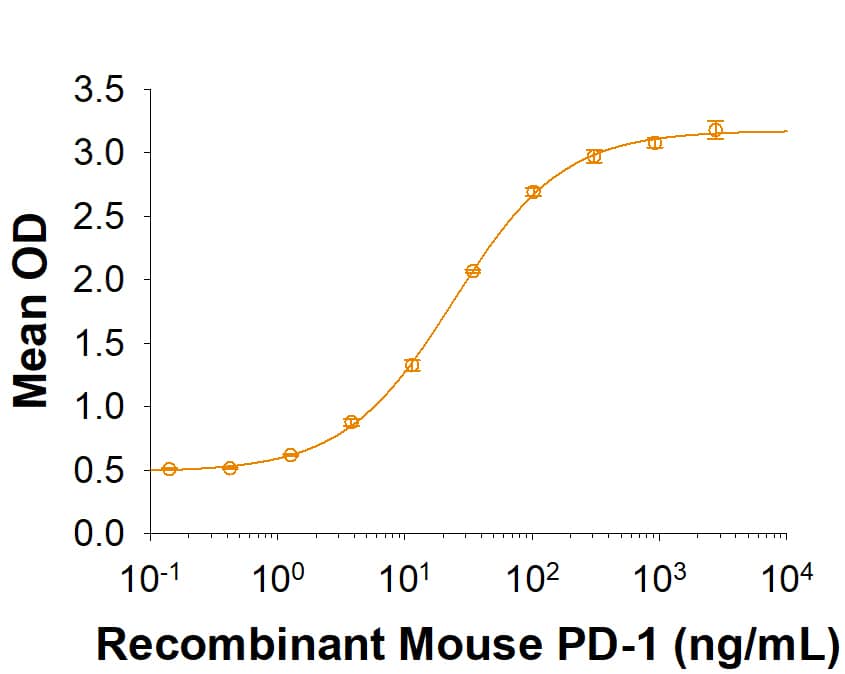Recombinant Mouse PD-L1/B7-H1 His-tag Protein, CF
R&D Systems, part of Bio-Techne | Catalog # 9048-B7

Key Product Details
- R&D Systems NS0-derived Recombinant Mouse PD-L1/B7-H1 His-tag Protein (9048-B7)
- Quality control testing to verify active proteins with lot specific assays by in-house scientists
- All R&D Systems proteins are covered with a 100% guarantee
Product Specifications
Source
Mouse myeloma cell line, NS0-derived mouse PD-L1/B7-H1 protein
Phe19-His239, with a C-terminal 6-His tag
Phe19-His239, with a C-terminal 6-His tag
Purity
>95%, by SDS-PAGE visualized with Silver Staining and quantitative densitometry by Coomassie® Blue Staining.
Endotoxin Level
<0.10 EU per 1 μg of the protein by the LAL method.
N-terminal Sequence Analysis
Phe19
Predicted Molecular Mass
26 kDa
SDS-PAGE
49-62 kDa, reducing conditions
Activity
Measured by its binding ability in a functional ELISA.
When Recombinant Mouse PD-L1/B7-H1 is immobilized at 25 ng/mL (100 µL/well), the concentration of Recombinant Mouse PD-1 Fc Chimera (Catalog # 1021-PD) that produces 50% of the optimal binding response is approximately 8-40 ng/mL
When Recombinant Mouse PD-L1/B7-H1 is immobilized at 25 ng/mL (100 µL/well), the concentration of Recombinant Mouse PD-1 Fc Chimera (Catalog # 1021-PD) that produces 50% of the optimal binding response is approximately 8-40 ng/mL
Reviewed Applications
Read 13 reviews rated 5 using 9048-B7 in the following applications:
Scientific Data Images for Recombinant Mouse PD-L1/B7-H1 His-tag Protein, CF
Recombinant Mouse PD-L1/B7-H1 His-tag Protein Binding Activity
When Recombinant Mouse PD-L1/B7-H1 is immobilize at 25 ng/mL, it binds Recombinant Mouse PD-1 Fc Chimera (Catalog # 1021-PD) with an ED50 of 8-40 ng/mL.Formulation, Preparation and Storage
9048-B7
| Formulation | Lyophilized from a 0.2 μm filtered solution in PBS. |
| Reconstitution |
Reconstitute at 400 μg/mL in PBS.
|
| Shipping | The product is shipped at ambient temperature. Upon receipt, store it immediately at the temperature recommended below. |
| Stability & Storage | Use a manual defrost freezer and avoid repeated freeze-thaw cycles.
|
Background: PD-L1/B7-H1
References
- Ceeraz, S. et al. (2013) Trends Immunol. 34:556.
- Tamura, H. et al. (2001) Blood 97:1809.
- Chen, L. et al. (2007) J. Immunol. 178:6634.
- Kuang, D.-M. et al. (2014) J. Clin. Invest. 124:4657.
- Tsushima, F. et al. (2007) Blood 110:180.
- Mazanet, M.M. and C.C.W. Hughes (2002) J. Immunol. 169:3581.
- Cao, Y. et al. (2010) Cancer Res. 71:1235.
- Scandiuzzi, L. et al. (2014) Cell Rep. 6:625.
- Dong, H. et al. (2002) Nat. Med. 8:793.
- Azuma, T. et al. (2008) Blood 111:3635.
- Butte, M.J. et al. (2008) Mol. Immunol. 45:3567.
- Park, J.-J. et al. (2010) Blood 116:1291.
- Ritprajak, P. et al. (2010) J. Immunol. 184:4918.
- Herold, M. et al. (2015) J. Immunol. 195:3584.
Long Name
Programmed Death Ligand 1
Alternate Names
B7-H1, B7H1, CD274, PDCD1L1, PDCD1LG1, PDL1
Entrez Gene IDs
Gene Symbol
CD274
UniProt
Additional PD-L1/B7-H1 Products
Product Documents for Recombinant Mouse PD-L1/B7-H1 His-tag Protein, CF
Product Specific Notices for Recombinant Mouse PD-L1/B7-H1 His-tag Protein, CF
For research use only
